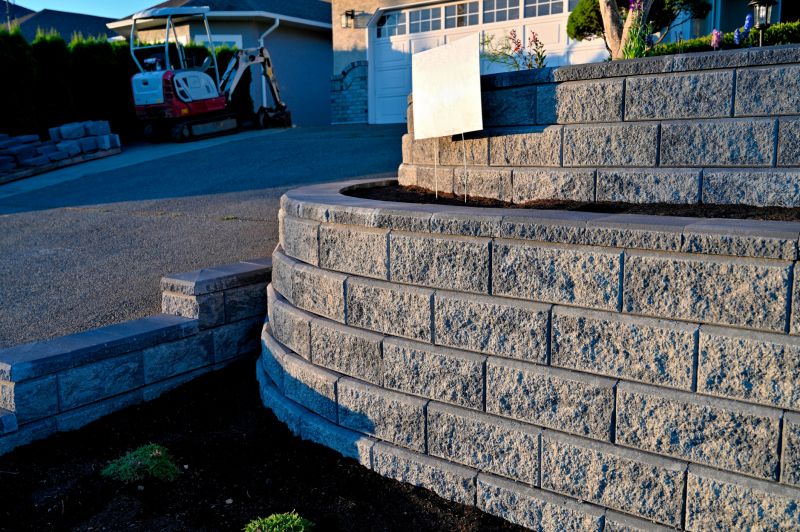Expert Picks For Essential Retaining Wall Repair Supplies
Find out which repair products professionals trust for reinforcing and restoring retaining walls to withstand the test of time.
 Retaining wall repairs often require a variety of products designed to restore stability, enhance durability, and improve the appearance of existing structures. These products are essential for addressing common issues such as shifting, cracking, or leaning walls caused by soil pressure, weather conditions, or age. Selecting the right repair materials depends on the specific type of wall, the extent of damage, and the desired longevity of the repair. From mortar and concrete patching compounds to reinforcement options, there is a broad spectrum of solutions tailored to different needs.
Retaining wall repairs often require a variety of products designed to restore stability, enhance durability, and improve the appearance of existing structures. These products are essential for addressing common issues such as shifting, cracking, or leaning walls caused by soil pressure, weather conditions, or age. Selecting the right repair materials depends on the specific type of wall, the extent of damage, and the desired longevity of the repair. From mortar and concrete patching compounds to reinforcement options, there is a broad spectrum of solutions tailored to different needs.
Top Overall Option
Versatile Retaining Wall Repair Compound
A multi-purpose repair compound designed for filling cracks, sealing joints, and reinforcing weak spots in various retaining wall materials. It offers excellent adhesion, weather resistance, and ease of application, making it suitable for a wide range of repair scenarios. Its formulation helps improve the structural integrity of walls while providing a smooth finish for aesthetic purposes.
Types of Products For Retaining Wall Repairs
Concrete Patch
Used for filling cracks and holes in concrete walls, providing a durable and weather-resistant surface.
Mortar Mix
Ideal for re-pointing and bonding brick or stone walls, ensuring stability and a seamless finish.
Epoxy Resin
A strong adhesive for bonding broken or cracked wall sections, suitable for structural reinforcement.
Waterproof Sealant
Applied to protect walls from moisture ingress, preventing further deterioration.
Reinforcement Mesh
Provides additional structural support, especially in large or heavily damaged walls.
Grout
Fills gaps between stones or bricks, enhancing stability and appearance.
Polyurethane Foam
Expands to fill voids and cracks, offering quick stabilization in small areas.
Anchor Bolts
Secures loose sections and attaches reinforcement components to existing structures.
Drainage Pipe
Helps manage water flow behind the wall, reducing pressure and preventing damage.
Geo-textile Fabric
Used for soil stabilization and preventing erosion around the wall base.
Soil Stabilizer
Improves soil cohesion and reduces movement around the wall foundation.
Gravel Backfill
Provides proper drainage and reduces pressure on the wall structure.
Concrete Blocks
Replacement or reinforcement elements for rebuilding or strengthening sections.
Vapor Barrier
Prevents moisture from seeping through the wall, protecting internal materials.
Expansion Joint Material
Allows for movement and prevents cracking due to temperature changes.
Popular Choices
Widely used for sealing cracks and small repairs in concrete retaining walls.
Popular for re-pointing and bonding brick or stone structures with some flexibility.
Commonly chosen for bonding and reinforcing damaged wall sections.
Used to create a waterproof barrier on the wall surface.
Frequently selected for added support in larger repairs.
Popular for sealing joints and cracks with flexibility and durability.
Commonly used for backfill to improve drainage behind the wall.
Often used to secure loose or leaning wall sections.
Selected for stabilizing soil and preventing erosion around the wall.
Popular for quick filling of small cracks and voids.
Used to strengthen concrete or masonry walls during repair.
Commonly installed behind walls to facilitate water movement.
Chosen for filling larger gaps with good adhesion and flexibility.
Many repair projects benefit from versatile products that can be used for multiple applications, including sealing cracks, filling gaps, and reinforcing weak points. Proper preparation and choosing compatible repair materials are critical for ensuring the effectiveness of the repair work. Additionally, some products are formulated to withstand environmental stresses such as moisture and temperature fluctuations, helping to prolong the lifespan of the wall.
When considering repairs, it is important to evaluate the existing wall’s construction type—whether it is made of concrete, stone, or brick—as this influences the choice of repair products. Using the appropriate tools and techniques alongside these products can significantly improve the outcome. Regular maintenance and timely repairs can help prevent further deterioration, ensuring that the retaining wall continues to perform its structural role effectively.
Overall, understanding the variety of available repair products and their specific applications can help homeowners and contractors make informed decisions. Properly selected materials can facilitate more durable, stable, and visually appealing repairs, ultimately extending the functional life of retaining walls and maintaining landscape integrity.
Key Buying Considerations
- Compatibility with existing wall materials such as concrete, brick, or stone.
- Extent and type of damage to determine appropriate repair products.
- Environmental conditions like moisture, temperature fluctuations, and exposure to elements.
- Ease of application and whether professional assistance is needed.
- Durability and longevity of the repair materials under local conditions.
- Ability to accommodate future movement or settling of the wall.
- Water resistance and waterproofing features of the product.
- Compatibility with drainage systems and backfill materials.
- Availability of reinforcement options for structural support.
- Ease of surface preparation required before applying repair products.
- Cost considerations and availability of repair kits or individual components.
- Safety and handling instructions for the repair materials.
- Aesthetic considerations if visible repairs are necessary.
- Compatibility with existing reinforcement or structural elements.
- Manufacturer instructions and warranty information.
